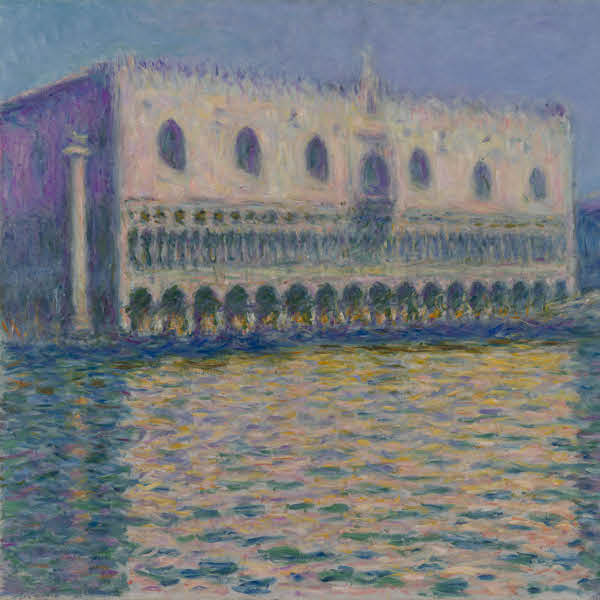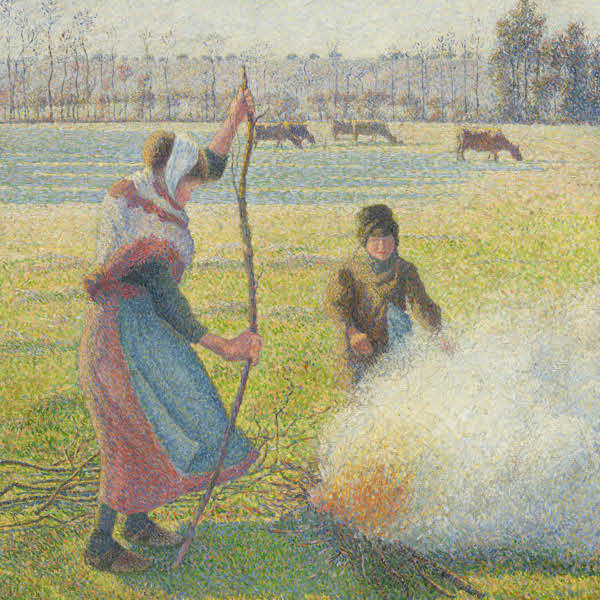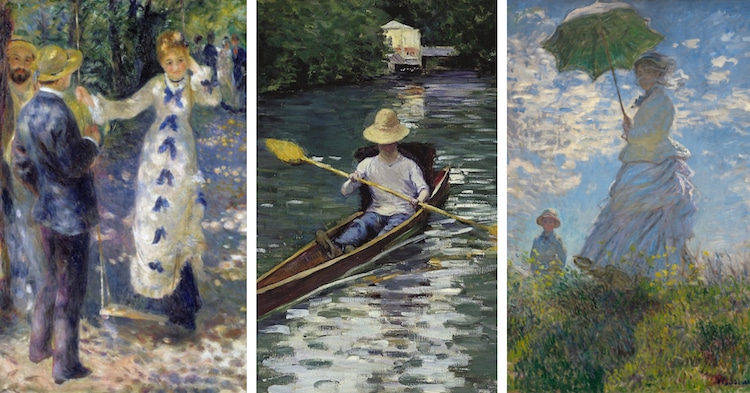
No artists have captured the carefree nature of the summertime quite like the Impressionists. With an inherent interest in painting en plein air, the season's warm weather, ample sunlight, and long, leisurely days made summer particularly appealing to the artists, whose sun-dappled canvases continue to make a splash today.
In order to illustrate this artistic interest, we've put together a selection of our favorite seasonal Impressionist paintings. Featuring boats, beaches, and everything in between, these light and airy works are sure to put you in the mood for summer.
Dive into this selection of summery Impressionist paintings.
La Grenouillère by Claude Monet
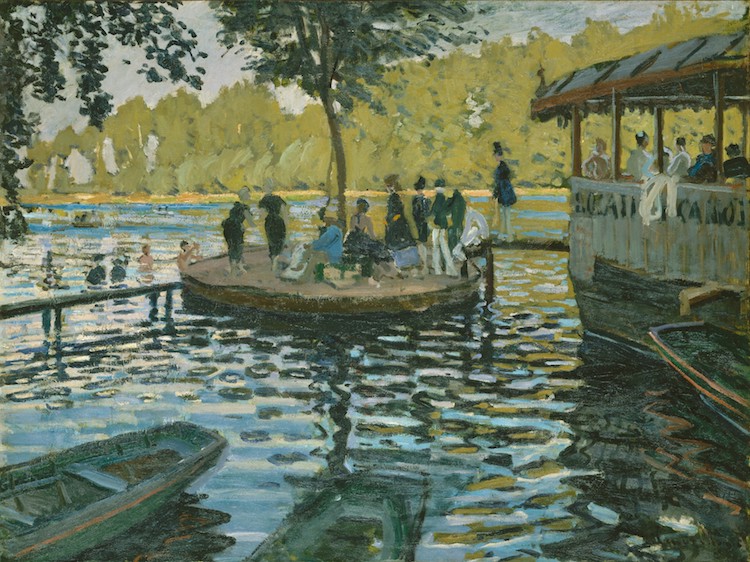
Claude Monet, “Bain à la Grenouillère” 1869 (Photo: Wikimedia Commons Public Domain)
Impressionism officially emerged in 1872. However, most of the movement's pioneers were producing works in the Impressionist style years prior. One piece that illustrates this is Bain à la Grenouillère, a painting of a popular boating resort located just outside of Paris. Completed by Claude Monet in 1869, this work captures several key qualities of Impressionism, including the use of broad brushstrokes, a vivid color palette, and an interest in capturing the fleeting effects of light on water.
The Luncheon of the Boating Party by Pierre-Auguste Renoir

Pierre-Auguste Renoir, “The Luncheon of the Boating Party,” 1880-1881 (Photo: Wikimedia Commons Public Domain)
During the late 19th century, boating became a favorite pastime among Parisian artists—and Monet was not the only one to take notice. Pierre-Auguste Renoir immortalized this phenomenon in The Luncheon of the Boating Party, one of his most celebrated paintings. Set on the sunlit balcony of the Maison Fournaise, a restaurant that offered rowboat rentals, this piece captures the jovial atmosphere of the site, which Renoir found particularly inspiring.
“You could find me any time at Fournaise’s,” he wrote. “There, I was fortunate enough to find as many splendid creatures as I could possibly desire to paint.”
Canoe on the Yerres River by Gustave Caillebotte

Gustave Caillebotte, “Canoe on the Yerres River,” 1878 (Photo: Wikimedia Commons Public Domain)
One of the “splendid creatures” Renoir regularly met at the Maison Fournaise is fellow artist Gustave Caillebotte (in fact, you can find him in the lower righthand corner of The Luncheon of the Boating Party). Caillebotte, a member of the prestigious Sailing Club of Paris, enjoyed boating. His interest in the sport is particularly apparent in his works from 1877 and 1878. During this time, he completed many paintings of boaters, including Canoe on the Yerres River, a piece that shows a lone rower sailing through jade-green waters.
The Boating Party by Mary Cassatt
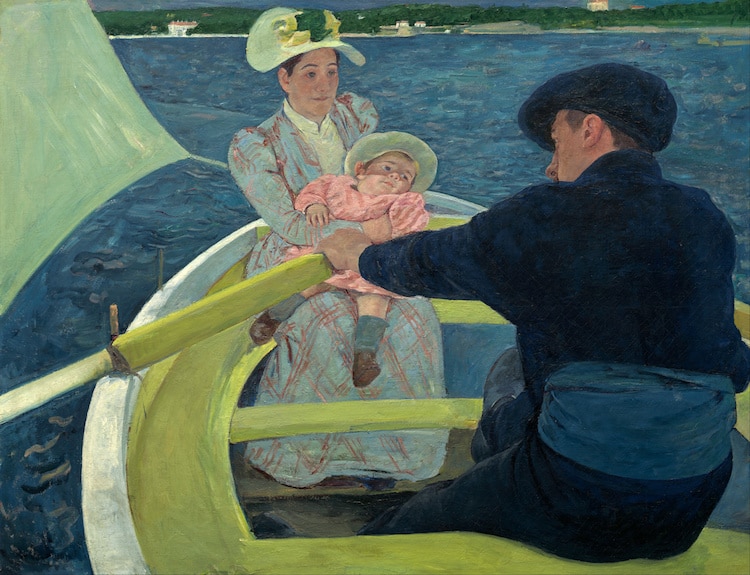
Mary Cassatt, “The Boating Party,” 1893-1894 (Photo: Wikimedia Commons Public Domain)
This affinity for aquatic leisure is also apparent in The Boating Party, a painting by American artist Mary Cassatt. Like much of her work, this piece features a mother and child as its primary subjects. It also showcases her forward-thinking approach to art, characterized by her penchant for exaggerated color and use of loose-yet-refined forms.
“Here, citron and blue carve strong arcs that divide the picture into assertive, almost abstract, shapes,” the National Gallery of Art explains. “This picture, with its bold geometry and decorative patterning of the surface, positions Cassatt with such Post–Impressionist painters as Gauguin and Van Gogh.”
Woman with a Parasol – Madame Monet and Her Son by Claude Monet
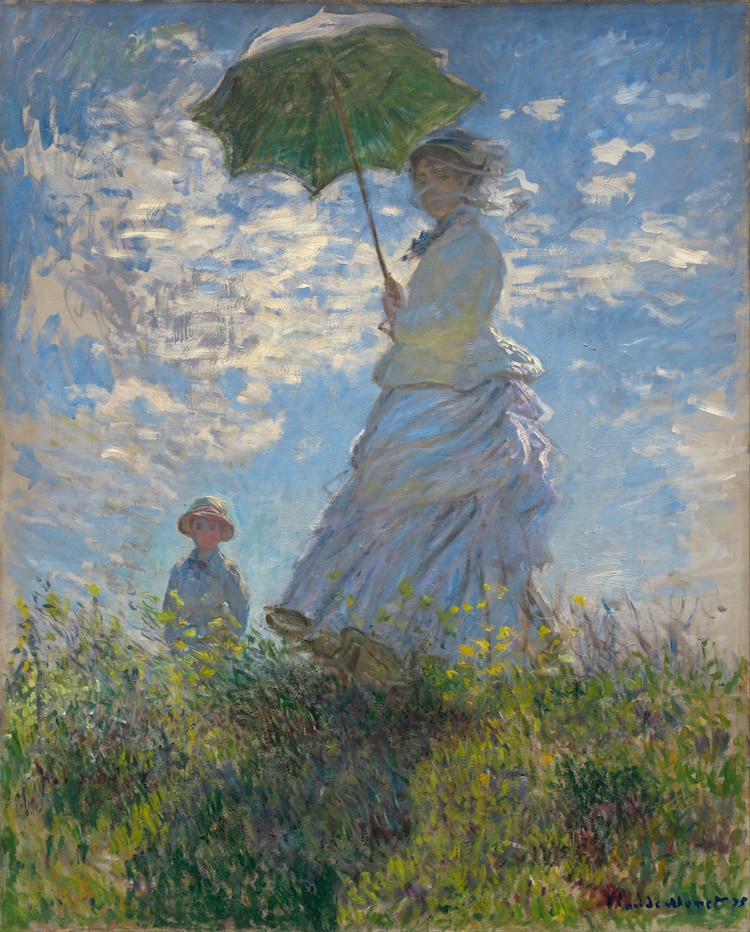
Claude Monet , “Woman with a Parasol – Madame Monet and Her Son,” 1875 (Photo: Wikimedia Commons Public Domain)
Monet also dabbled in depictions of mothers with their children. His paintings, however, often starred his own wife, Camille. Woman with a Parasol is one of the most well-known of these works. Set in Argenteuil—a suburb of Paris that the family called home from 1872 through 1878—the painting portrays his partner and their young son spending a breezy day in a sun-drenched meadow. This carefree interpretation of nature is characteristic of the painter, who once noted that he “would like to paint the way a bird sings.”
Cliff Walk at Pourville by Claude Monet

Claude Monet, “Cliff Walk at Pourville,” 1882 (Photo: Wikimedia Commons Public Domain)
In 1882, Monet spent several dreamy months in Pourville, a commune in Normandy's countryside. As always, the nature-loving artist found ample artistic inspiration in his scenic surroundings, including, above all else, the flower-covered cliffs and turquoise water of its idyllic coast. In Cliff Walk at Pourville, Monet depicts two women—likely his second wife, Alice, and her daughter—as they explore “the delightful nooks and crannies” of this sunny seaside town.
The Swing by Pierre-Auguste Renoir
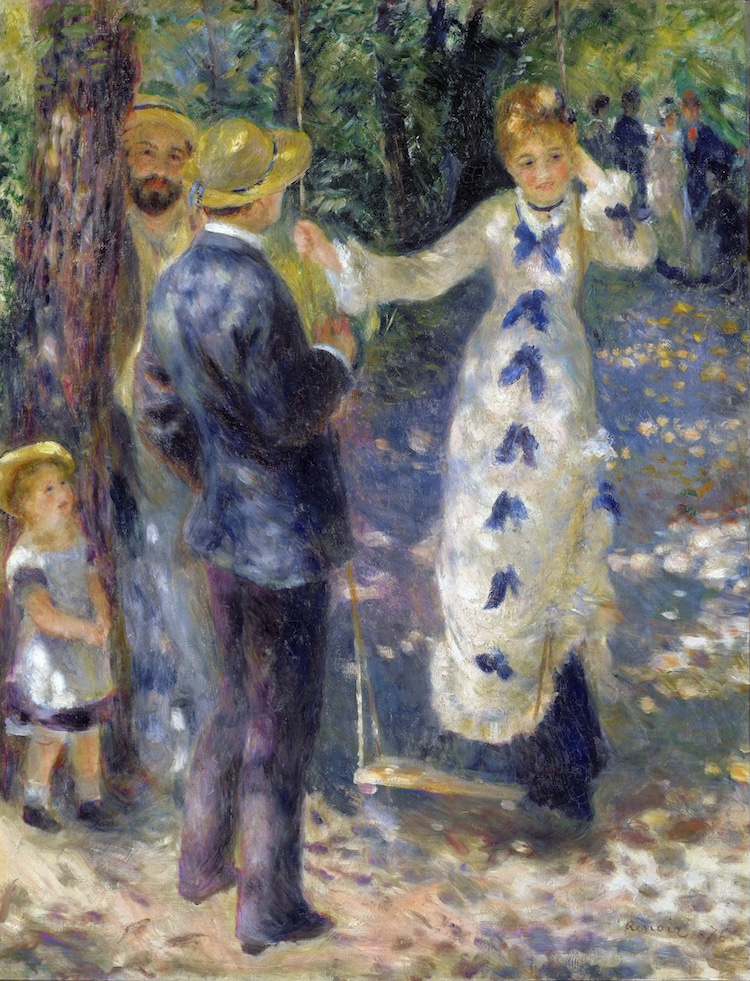
Pierre-Auguste Renoir, “The Swing,” 1876 (Photo: Wikimedia Commons Public Domain)
In 1876, Pierre-Auguste Renoir painted The Swing, a snapshot of the artist's brother, Edmond, and Jeanne, one of the artist's Montmarte-based models, in a Parisian park. While these subjects can be found front and center, much of the painting's focus is actually on the atmosphere—especially the effects of light.
“Renoir is particularly trying to catch the effects of sunlight dappled by the foliage,” the Musée d'Orsay explains. “This particularly annoyed the critics when the painting was shown at the Impressionist exhibition of 1877. The Swing nonetheless found a buyer—Gustave Caillebotte, who also bought The Ball at the Moulin de la Galette.”
The Ball at the moulin de la Galette by Pierre-Auguste Renoir
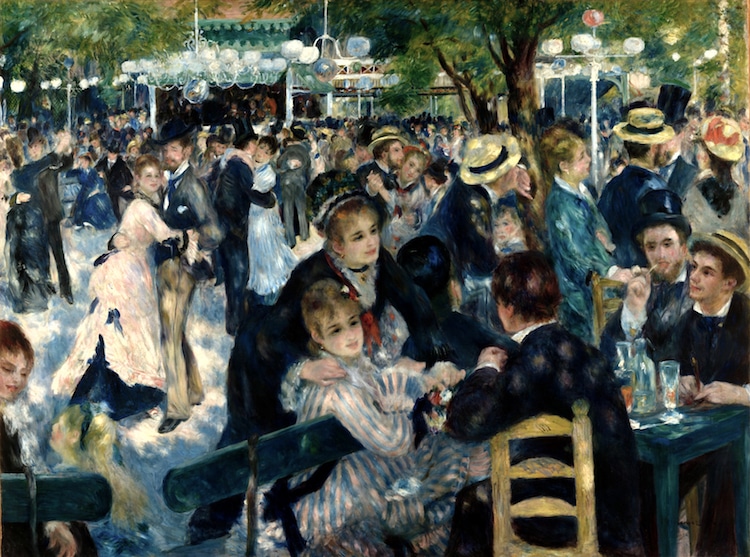
Pierre-Auguste Renoir, “The Ball at the moulin de la Galette,” 1876 (Photo: Wikimedia Commons Public Domain)
The Swing and The Ball at the Moulin de la Galette—a large-scale painting of people enjoying a sunny afternoon in Paris—have more in common than just a buyer. Both were painted in the summer of 1876; both feature Edmond and Jeanne; and, of course, both capture Renoir's interest in capturing sunbeams streaming through the trees.
“The study of the moving crowd, bathed in natural and artificial light, is handled using vibrant, brightly coloured brushstrokes,” the Musée d'Orsay says. “This portrayal of popular Parisian life, with its innovative style and imposing format, a sign of Renoir's artistic ambition, is one of the masterpieces of early Impressionism.”
Man on a Balcony, Boulevard Haussmann by Gustave Caillebotte
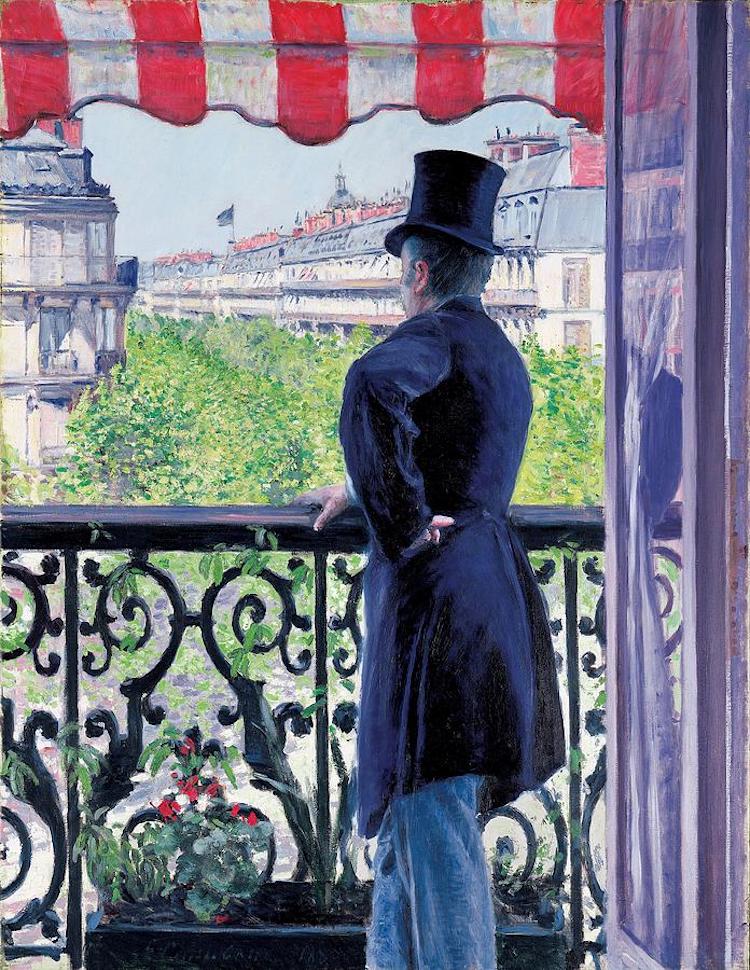
Gustave Caillebotte, “Man on a Balcony, Boulevard Haussmann,” 1880 (Photo: Wikimedia Commons Public Domain)
While Impressionist artists are known for their interest in painting en plein air, not all of their works take place outside. Still, even when set indoors, many of these paintings showcase the artists' innate love of nature. Man on a Balcony, Boulevard Haussmann, a work by French artist Gustave Caillebotte, typifies this approach.
Though based in an apartment, the painting is heavily focused on the sunny, tree-lined street, as well as the colorful flowers, intricate railings, and striped awnings characteristic of 19th-century Parisian balconies. This unique composition epitomizes the Impressionist's ability to celebrate summer in all its forms—whether experienced en plein air or otherwise.
Related Articles:
25 Art History Terms to Help You Skillfully Describe a Work of Art
8 World-Famous Artists Who Were Drawn to Working in Pastel
8 Real-Life Locations of Famous Paintings You Can Visit Today
Fascinating Paintings Reveal the Unique Studios of 5 Famous Artists













































































